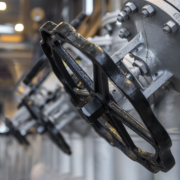A potential risk: Thermal oil fire in the heater – Effective solutions to be prepared in case of emergency
The operation of thermal oil plants brings about several sources of danger. For many of them, there are effective measures that can be taken to prevent the worst from happening and to increase the overall plant safety in the long term. In the last article on the subject of “Pump monitoring in thermal oil systems“, we already reported on the importance of such measures.
Another source of danger is the possibility of a thermal oil fire inside the heater. This can occur if, for example, cracks form on the coil of the heater due to abrasion (solid fuel combustion), fatigue, overheating or corrosion, leading to leakage. The escaping thermal oil ignites and eventually leads to an uncontrolled fire with very strong heat and smoke development.
“The process from the first hairline cracks in the coil to a fire of thermal oil in the heater is often gradual. In addition to consistent maintenance, it therefore makes sense to be prepared for the worst case scenario. Because when it happens, quick action is required,” says Dietmar Ness, one of the managing directors of NESS Wärmetechnik GmbH.
In this case, there are two effective, fully automatic and proven ways to extinguish such a fire. One solution is to remove the oxygen from the fire that has broken out. For this purpose, an inert gas – usually argon or nitrogen – is injected into the heater. Argon is significantly heavier than air, which means that the heater can be optimally flooded with it.
However, as effective as this method is, it also has its disadvantages. If the heater is opened, the gas escapes and the fire may re-ignite on the still hot surfaces. In addition, the risk of asphyxiation for persons must also be considered.
The second and much more elegant solution is to extinguish the fire with a very fine water mist. The resulting steam in the hot atmosphere displaces the oxygen and smothers the flame. The water mist is necessary because a focused jet would evaporate abruptly when it hit hot surfaces, possibly causing damage.
The water mist can achieve something else in addition to the actual extinguishing effect – a lasting cooling of the fire source. This is the best possible precaution against re-ignition when the heater is opened.
“Both technical solutions have proven themselves over the years and are used internationally, whereby the variant with water mist is usually the preferred one. NESS heaters are usually prepared for a corresponding retrofit. We would be happy to check whether integration can also be realised on heaters from other manufacturers,” says Dietmar Ness.













